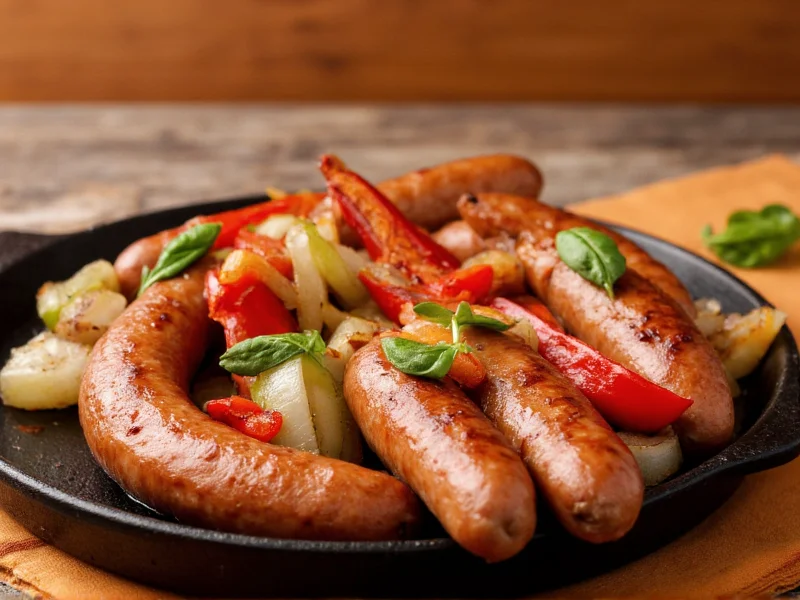Sausage and peppers and onions represents one of America's most beloved Italian-American comfort foods, combining simple ingredients into a flavorful, versatile meal. This dish originated in New York City's Italian neighborhoods during the early 20th century when immigrants adapted their traditional recipes using locally available ingredients. The combination of savory sausage with sweet bell peppers and onions creates a perfect balance of flavors that has stood the test of time.
The Essential Components of Authentic Sausage and Peppers
Creating the perfect sausage and peppers and onions starts with understanding each component's role. Traditional recipes use Italian sausage as the protein base, though many home cooks wonder what kind of sausage is best for peppers and onions. Sweet Italian sausage remains the most popular choice, but hot Italian sausage adds welcome spice for those who enjoy heat. Some regional variations incorporate chicken sausage or even plant-based alternatives for dietary preferences.
Bell peppers provide the dish's signature sweetness and color contrast. Most authentic recipes call for a combination of red, yellow, and green peppers, though some traditionalists insist on using only green peppers for authenticity. The onions—typically yellow onions—caramelize during cooking, adding depth and natural sweetness that balances the sausage's richness.
| Ingredient | Traditional Amount | Preparation Tip |
|---|---|---|
| Italian sausage | 1.5 lbs | Remove from casings for skillet cooking |
| Bell peppers | 3 medium | Sliced 1/4-inch thick for even cooking |
| Yellow onions | 2 large | Sliced lengthwise to maintain structure |
| Olive oil | 3 tbsp | Use extra virgin for authentic flavor |
Step-by-Step Preparation Guide
Mastering how to make sausage and peppers and onions requires attention to cooking sequence and timing. Begin by heating olive oil in a large skillet or cast-iron pan over medium heat. Add the sausage—either left in links or removed from casings and broken into chunks—and brown thoroughly, about 8-10 minutes. Remove the sausage and set aside, leaving the flavorful drippings in the pan.
Next, add the onions to the same pan, cooking until they begin to soften (about 5 minutes). Add the peppers and continue cooking until both vegetables show signs of caramelization but still maintain some texture—approximately 12-15 minutes. Return the sausage to the pan, add 2 minced garlic cloves, 1 teaspoon dried oregano, and a splash of either white wine or red wine vinegar. Cover and simmer for 10 minutes to allow flavors to meld.
The secret to perfect Italian sausage peppers and onions recipe success lies in not overcrowding the pan, which prevents proper caramelization. Cook in batches if necessary, and resist the urge to stir too frequently—allowing the vegetables to sit promotes that desirable golden-brown sear.
Variations and Customizations
While the classic preparation remains popular, many families have developed their own sausage peppers onions variations over generations. Some add crushed tomatoes for a saucier version, while others incorporate mushrooms or olives for additional flavor dimensions. For those seeking a healthy sausage and peppers recipe, using turkey sausage and increasing the vegetable-to-meat ratio creates a lighter meal without sacrificing flavor.
Cooking methods vary across regions—some prefer grilling the sausage first before combining with sautéed vegetables, while others cook everything together in a single pot for deeper flavor integration. The Philadelphia version often includes a splash of vinegar for brightness, while New York preparations might feature a touch of sugar to enhance caramelization.
Serving Suggestions and Meal Pairings
The versatility of sausage and peppers meal prep makes it suitable for various presentations. The most traditional serving method involves spooning the mixture onto crusty Italian bread rolls for hearty sandwiches. Many Italian-American families serve it over pasta, polenta, or with crusty bread for dipping into the flavorful juices.
For weeknight efficiency, prepare a large batch and use throughout the week in different applications: as a pizza topping, filling for omelets, or alongside roasted potatoes for a complete meal. Leftovers maintain excellent quality when stored properly, making this an ideal quick sausage peppers onions weeknight meal solution.
Troubleshooting Common Issues
When preparing traditional sausage and peppers cooking method, several issues may arise. If vegetables release too much liquid, increase heat to evaporate excess moisture. For overly dry results, add a splash of broth or water during the final simmering stage. Sausage that browns too quickly indicates heat that's too high—maintain medium heat for even cooking without burning.
Many home cooks struggle with achieving the perfect vegetable texture—neither mushy nor too crisp. The solution lies in adding peppers after onions since they require less cooking time. For those wondering how to keep peppers and onions from burning, occasional stirring combined with proper heat management prevents scorching while still allowing desirable caramelization.











 浙公网安备
33010002000092号
浙公网安备
33010002000092号 浙B2-20120091-4
浙B2-20120091-4